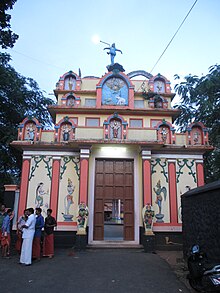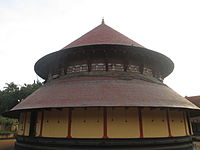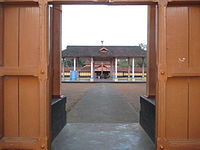Thiruvanvandoor Mahavishnu Temple
| Thiruvanvandoor Mahavishnu Temple | |
|---|---|
 | |
| Religion | |
| Affiliation | Hinduism |
| District | Alapuzha |
| Deity | Pambanaiappan (Vishnu) Gosala Krishna (Vishnu) |
| Location | |
| Location | Thiruvanvandoor |
| State | Kerala |
| Country | India |
Location inKerala | |
| Geographic coordinates | 9°20′35″N76°34′47″E/ 9.34306°N 76.57972°E |
| Architecture | |
| Type | Dravidian architecture |

TheThiruvanvandoor Mahavishnu Templeis aHindu templededicated toVishnuand located inThiruvanvandoor,Alappuzha District,Kerala,South India.Constructed in theKerala style of architecture,the temple is glorified in theNalayira Divya Prabandham,the early medievalTamilcanon of theAlvarsaints from the 6th–9th centuries CE. It is one of the 108Divya Desamsdedicated toVishnu,who is worshipped as Paambanaiappan. The nearest railway station to the temple is located inChengannur,while the nearest airport isTrivandrum International Airport.
It is one of the five ancient shrines in theChengannurarea of Kerala, connected with the legend ofMahabharata,where the fivePandavasare believed to have built one temple each;Thrichittatt Maha Vishnu TemplebyYudhishthira,Puliyur Mahavishnu TemplebyBheema,Aranmula Parthasarathy TemplebyArjuna,Thiruvanvandoor Mahavishnu Temple byNakulaandThrikodithanam Mahavishnu TemplebySahadeva.
The temple is open from 4 am to 11:00 am and 5 pm to 8 pm and is administered byTravancore Devaswom Boardof theGovernment of Kerala.
Legend and history
[edit]
It is one of the five ancient shrines in theChengannurarea of Kerala, connected with the legend ofMahabharata.Legend has it that thePandavaprinces, after crowningParikshitas king ofHastinapuraleft on a pilgrimage. On arriving on the banks of riverPamba,each one is believed to have installed a tutelary image of Krishna;Thrichittatt Maha Vishnu TemplebyYudhishthira,Puliyur Mahavishnu TemplebyBhima,Aranmula Parthasarathy TemplebyArjuna,Thiruvanvandoor Mahavishnu Temple byNakulaandThrikodithanam Mahavishnu TemplebySahadeva.[1][2]
The famousPambariver is near the temple and hence the name of the deity is Paambanaiappan. As per another legend, the temple is believed to be consecrated by the sageBhrigu.The temple is counted as one of the five temples built and worshipped by Pandavas fromMahabharatha.[3]
Earliest references to this temple appear in the poems and hymns composed by the greatest of Alvar saints -Nammalvar,in circa 800 CE. Stone inscriptions in the temple date it back to the SecondCheraEmpire (800 - 1102 CE).[4]The temple is open from 4 am to 11:00 am and 5 pm to 8 pm and is administered byTravancore Devaswom Boardof theGovernment of Kerala.
Architecture
[edit]
The temple is built inKerala style architecture,which is common in all temples in the South Indian state of Kerala in Eastern axis. The temple has a two storeyedgopuramor a gateway tower, with the upper story having wooden trails covering theKottupura(a hall of drum beating during festivals). A rectangular wall around the temple, calledKshetra-Madillukapierced by the gateways, encloses all the shrines of the temple. The metal plated flagpost ordvajasthambamis located axial to the temple tower leading to the central sanctum and there is aDeepastamba,which is the light post.Chuttuambalamis the outer pavilion within the temple walls. The central shrine and the associated hall is located in a rectangular structure calledNallambalam,which has pillared halls and corridors.[5]Between the entrance ofNallambalamto the sanctum, there is a raised square platform calledNamaskara Mandapawhich has a pyramidal roof.Thevrapura,the kitchen used to cook offering to the deity is located on the left ofNamaskara Mandapafrom the entrance.Balitharais an altar is used for making ritualistic offering to demi-gods and the festive deities. The central shrine calledSreekovilhouses the image of the presiding deity. It is on an elevated platform with a single door reached through a flight of five steps. Either sides of the doors have images of guardian deities calleddvarapalakas.As per Kerala rituals, only the main priest calledThantriand the second priest calledMelshanthialone can enter theSree Kovil.[6]The central shrine has a circular plan with the base built of granite, superstructure built of laterite and conical roof made of terracata tile supported from inside by a wooden structure. The lower half ofSree Kovilconsists of the basement, the pillar or the wall, calledstambhaorbhithiand the entablature calledprastharain the ratio 1:2:1, in height. Similarly the upper half is divided into the neck calledgriva,the roof tower calledshikharaand the conicalkalasam(made of copper) in the same ratio. The roof projects in two levels to protect the inner structure from heavy rains during monsoon. The roof of the temple and some of the pillars have lavish wood and stucco carvings depicting various stories of ancient epics,RamayanaandMahabharata.[7]The outer walls around the sanctum have a series of wooden frames housing an array of lamps, which are lit during festive occasions.[8]The temples have paintings on its walls dating back to early 18 century.[9]
Festival
[edit]The annualTiruvaymolifestival is celebrated in commemoration ofNammalvar,the saint poet of 8th century.[3]The annual 51-day festival to commemorate the installation of idol of Sreekrishna is concluded with Gajamela, where a parade of 21 caparisoned elephants is held. The floats depict depicting Puranic themes and are accompanied by music players playing Mayuranrithom, Krishnanattom, Karakom, Nadaswarom, Panchavadyam, and Pancharimelom. A team of Pancharimelam performers offer rendition during the event. During the eveningKathakaliperformers where artiste perform various historic themes.[10][11]
See also
[edit]References
[edit]- ^Cultural Heritage of Kerala 2008,pp. 44-45
- ^Rao 2012,pp. 17-20
- ^ab"Chengannur Taluk".Alapuzha District administration.Retrieved5 August2015.
- ^Temples of Kerala.
S. Jayashanker, Directorate of Census Operations, Kerala (Census of India, Special Studies) (May 1997).Temples of Kerala, page 304-305.
{{cite book}}:CS1 maint: multiple names: authors list (link) - ^Rao 2012,pp. 12-13
- ^Cultural Heritage of Kerala 2008,p. 139
- ^Subodh Kapoor, ed. (2002).The Indian Encyclopaedia: Kamli-Kyouk Phyu.Vol. 13. Genesis Publishing Pvt Ltd. p. 3963.ISBN9788177552577.
- ^Noble, William A. (1981). "The Architecture and Organization of Kerala Style Hindu Temples".Anthropos.76(1/2): 17.ISSN0257-9774.JSTOR40460291.
- ^Cultural Heritage of Kerala 2008,p. 151
- ^"Thiruvanvandoor temple fete concludes with Gajamela".The Hindu.19 May 2010.Retrieved22 August2015.
- ^"Thiruvanvandoor temple fete".The Hindu.20 May 2015.Retrieved22 August2015.
External links
[edit]- Cultural Heritage of Kerala.Kerala, India: DC Books. 2008.ISBN9788126419036.
- Rao, A.V. Shankaranaryana (2012).Temples of Kerala.Vasan Publications.ISBN978-81-89888-94-7.

